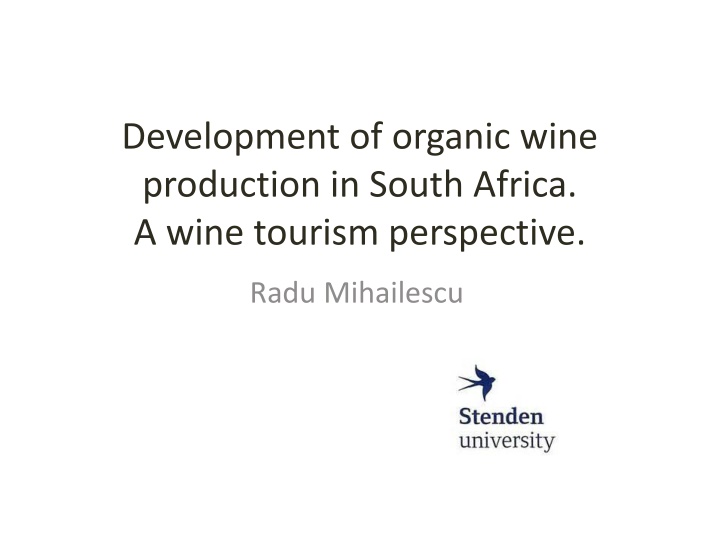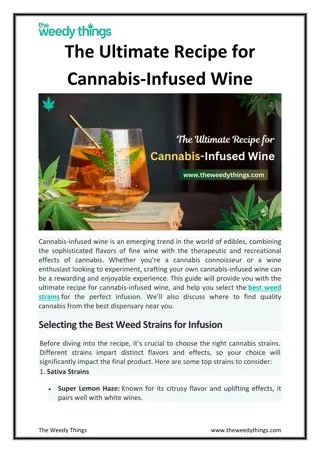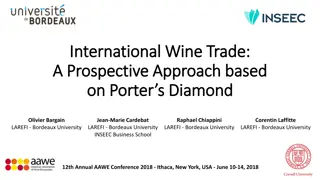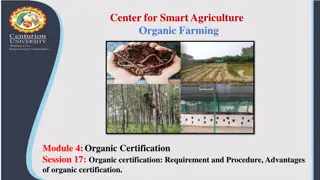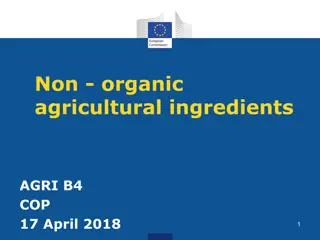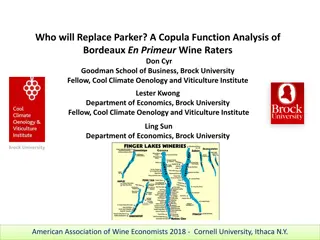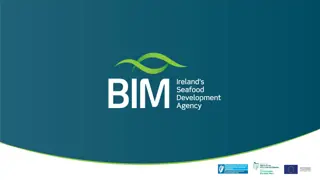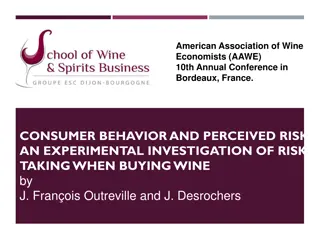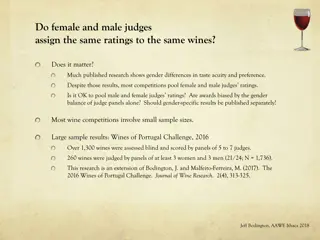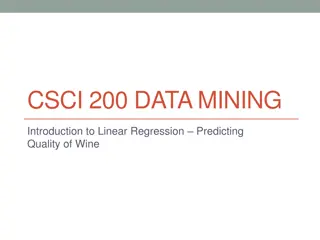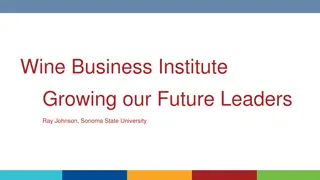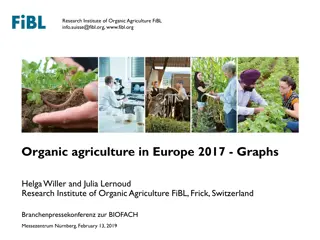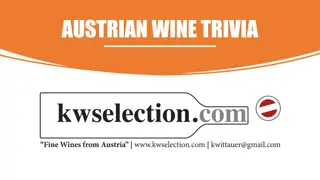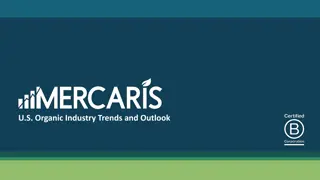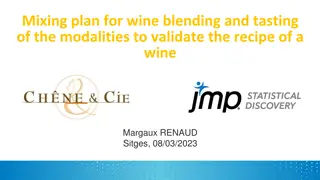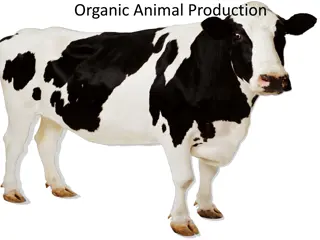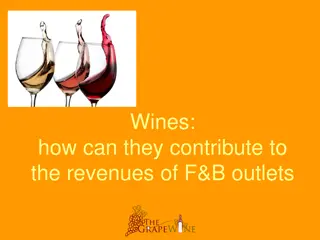Development of organic wine production in South Africa
Wine tourism in South Africa is a key driver of tourism development, with organic wine production gaining importance. This research explores the potential impact of organic wine production on attracting visitors and increasing wine sales. Using the Contingent Valuation Method, the study evaluates the Willingness to Pay of tourists visiting selected wine estates in the Western Cape. By examining consumer preferences and value perceptions, the research aims to provide insights for wine producers seeking competitive advantages in the growing wine tourism market.
Download Presentation

Please find below an Image/Link to download the presentation.
The content on the website is provided AS IS for your information and personal use only. It may not be sold, licensed, or shared on other websites without obtaining consent from the author.If you encounter any issues during the download, it is possible that the publisher has removed the file from their server.
You are allowed to download the files provided on this website for personal or commercial use, subject to the condition that they are used lawfully. All files are the property of their respective owners.
The content on the website is provided AS IS for your information and personal use only. It may not be sold, licensed, or shared on other websites without obtaining consent from the author.
E N D
Presentation Transcript
Development of organic wine production in South Africa. A wine tourism perspective. Radu Mihailescu
Wine tourism has recently been earmarked as an important driver of tourism development and it can represent a major contributor of rural economic development. The wine estates form an important component of the South African tourism industry with wine estates providing wine tasting as well as supporting restaurants, guest houses and shops.
Wine production worldwide in 2016, by country (in million hectoliters) Italy France Spain United States Australia China South Africa Chile Argentina Germany 0 10 20 30 40 50 60 Source: Statista, 2017
The competition in the wine tourism has increased rapidly, with many countries trying to capture a share of the tourism market. As a result in order to obtain competitive advantage among destination eco-friendly attributes and claims are starting to play a key role in attracting wine tourists as shown by a number of researchers (Getz and Brown, 2006, Orsolini and Boksberger, 2009, Holohan & Remaud, 2014 ).
Objective of the research The development of a with focus on : - Potential WTP revealed by the respondents using a contingency valuation method - The extent to which the Willingness to Pay can represent a signal for the wine producers in their quest for attracting more visitors and also in selling more wine products.
Methodology A hypothetical market situation for a good or service is created by means of the Contingent Valuation Method (CVM). CVM creates a hypothetical market situation for a given good or service. It tends to quantify the value consumers confer to products by associating that value with the sum of money they are willing to pay. (Kawagoe & Fukunaga, 2001; Sellers-Rubio & Nicolau-Gonzalbez, 2016 ) A total of 215 tourists were interviewed in different locations of selected hotels and wineyards in the Western Cape. Subjects were randomly intercepted to participate in the experiment. The wineyards selected were Avondale, Lazanou Organic vineyards and Reyneke Wines. These wineyards produce both organic as well as non- organic wines.
Methodology Each respondent was asked at the sampling point if he/she was willing to pay the difference between conventional and organic prices. In order to obtain the parameters estimates for each selected product, a Binomial Multiple Logistic Regression was applied. The method is based on the following formula: WTPij = + 1 (Pj) + 2 Yj + 3 j +F (Zj) Where: WTPij i consumer s willingness to pay for j type of wine; , 1, 2, 3. Coefficients to be estimated, where P is the organic price premium; Y Income level; quality attributes perceptions; Z Socio-demographic characteristics. The model was run separately for both white and red wines. The demographics of the respondents where explored based on the age, income country of origin.
Profile of the respondents (n = 215) Age 21-30 30-40 40-50 50 + Country of Origin South Africa UK Germany Netherlands Rest of the World 39 89 55 32 18% 41% 26% 15% 129 30 22 13 21 60% 14% 9% 6% 11%
The fit of the WTP function for red organic Dependent variable WTP Variable Coefficient Standard Error Z-Stat p-value Constant -40.209 12.25 -1.77 0.010 Awards 1.235 19.180 2.058 0.040 Taste 25.130 22.842 1.100 0.017 Quality Perception -1,710 12.710 -1,130 0.050 Certification 2.620 10.830 1.400 0.042 Recommendations 15.323 12.177 1.880 0.040
The fit of the WTP function for white organic Dependent variable WTP Variable Coefficient Standard Error Z-Stat p-value Constant -39.215 11.23 -1.54 0.026 Awards 1.219 18.180 1.058 0.037 Taste 26.539 20.142 1.119 0.045 Quality Perception -1,230 10.310 -1,429 0.039 Certification 2.301 10.133 1.735 0.049 Recommendations 13.450 10.717 1.960 0.034
Predicted WTP equation for the red and white organic wines WTP (red) = -40.209 + 1.235Award + 25.130Taste - 1.710Perception + 2.620Cert. + 15.323Rec WTP (white) = -39.215 + 1.219Award + 26.539Taste -1.230Perception + 2.301Cert. + 13.450Rec When the median values (obtained from the sample data) are substituted then predicted Median WTP (red) = R 32 (Eur 1.5) and Median WTP (white) = R 41 (Eur 2.67)
Potential benefits to the development of organic wine tourism 1. The WTP results show that the respondents might be willing to pay a premium for South African organic wines. 2. Taste and recommendations have the highest positive impacts on the WTP, which makes a case for an increase in marketing efforts by the wine producers. 3. Preliminary reports show that about 40% of the respondents have visited the wine farms after the experiment. 4. WTP only shows indication of purchase 5. Due to legislation the quality of organic wines differs greatly.
